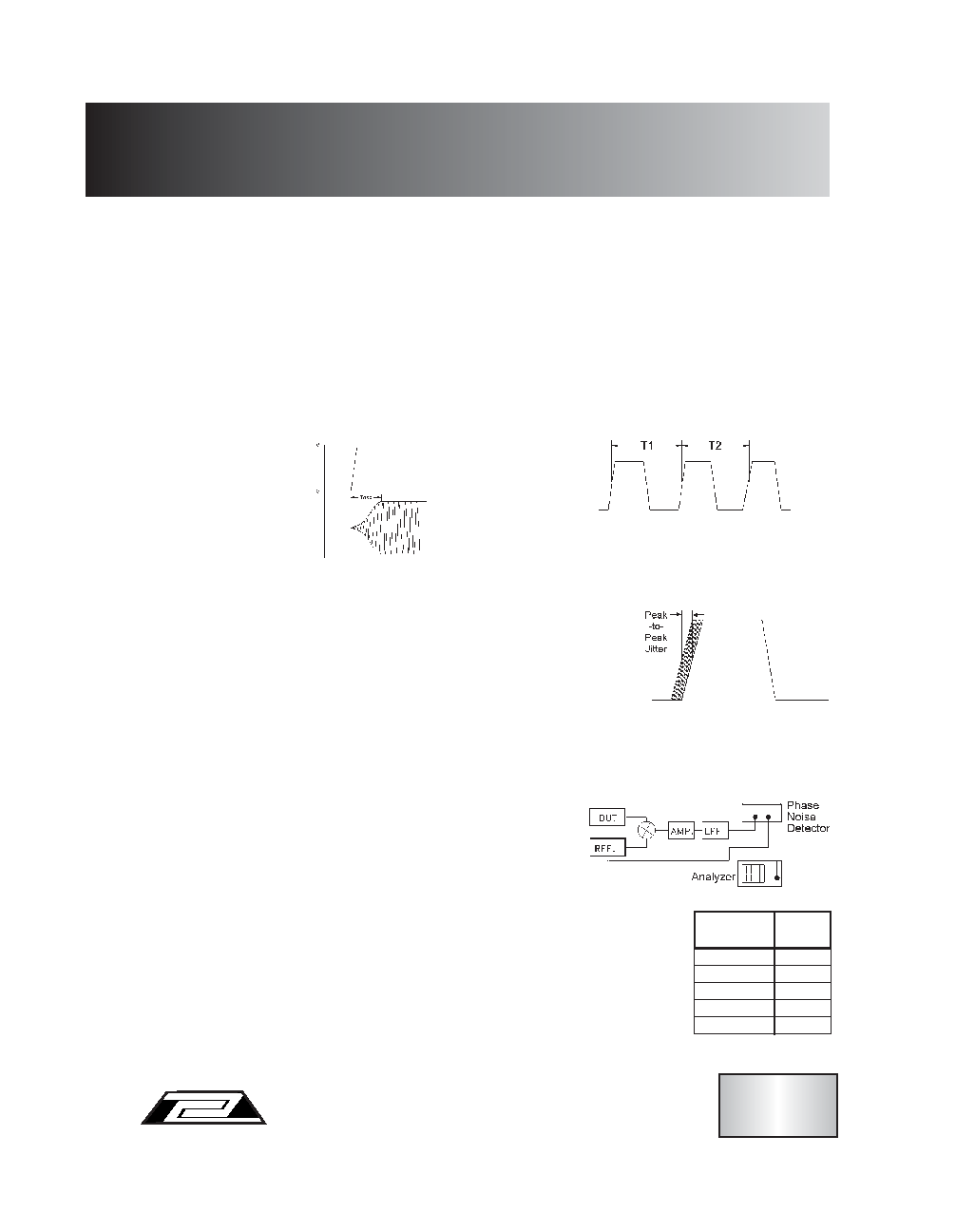- 您现在的位置:买卖IC网 > PDF目录235955 > ACVTX1018A-FREQ-C20-H5-OUT23 (ABRACON CORP) TCVCXO, CLOCK, 1 MHz - 26 MHz, CMOS/TTL OUTPUT PDF资料下载
参数资料
| 型号: | ACVTX1018A-FREQ-C20-H5-OUT23 |
| 厂商: | ABRACON CORP |
| 元件分类: | XO, clock |
| 英文描述: | TCVCXO, CLOCK, 1 MHz - 26 MHz, CMOS/TTL OUTPUT |
| 封装: | COMPACT, DIP-4 |
| 文件页数: | 4/6页 |
| 文件大小: | 177K |
| 代理商: | ACVTX1018A-FREQ-C20-H5-OUT23 |

29 Journey Aliso Viejo, CA 92656 USA
(949) 448-7070
FAX: (949) 448-8484
E-MAIL:
abinfo @ abracon.com INTERNET ADDRESS: www.abracon.com
ABRACON IS
ISO 9001 / QS 9000
CERTIFIED
CORPORA TION
ABRACON
-58 -
CRYSTAL OSCILLATORS
QUESTIONS AND ANSWERS
Q: Why the Overall frequency stability is specified in
crystal oscillators but not in crystals?
A: The crystal oscillator is typically used as a master clock for
the microprocessor and its parameters are not affected by the
internal characteristics of the microprocessor such as variation
in load capacitance and other variables that could affect the
change in frequency at room and over temperature. The over-
all frequency stability in crystal oscillators is typically ±100ppm
max. and includes frequency calibration at 25°C, over temper-
ature, frequency changes due to load, supply, aging, vibration,
and shock.
Q: What is the start-up time?
A: Start-up time is the delay time between the oscillation
starts from noise until it reaches its
full output amplitude when power is
applied. The supply voltage must be
applied with a defined rate or rise.
The start-up time varies from micro-
seconds to milliseconds depending
on frequency, ASIC speed and logic.
Please see figure 1.
Q: What is Tristate Enable/Disable mode?
A: When the voltage at the control pin is set to a logic low “0”,
the output is in Tri-state mode that is High Impedance. The
disabled current is usually lower than its normal operating cur-
rent but not completely cut-off as it was seen in the Stand-by
mode, where the oscillation is shut down completely.
There is an internal pull-up resistor between control pin and
supply (typically 100 k
), therefore the control pin can be left
open (floating) if unused.
Q: What is jitter and how to specify its maximum value?
A: Jitter is noise caused by many sources in crystal oscillators.
Major sources of noise are:
Power supply noise.
Integer multiples of the signal source frequency (harmonics).
Load and termination conditions.
Amplifier noise.
Circuit configuration (PLLs, Multiplier, Overtone, etc.)
The following methods can be used to suppress the noise condi-
tions in the above sources:
Make sure that the power supply noise is filtered by using
bypass capacitors, chip beads, or RC filters.
If jitter is critical in some applications, especially for high-
frequencies noise, use low harmonics outputs or sine output.
Make sure that load and termination conditions are opti-
mized to avoid reflected power back to its output.
Typically, PLLs, Multiplier or Programmable designs pro-
duce higher jitter than the conventional fundamental design.
It is very important to understand the jitter requirements from the
application to specify the right specification for crystal oscillators.
We can classify two types of jitters:
Cycle to cycle jitter
Period jitter.
CYCLE TO CYCLE JITTER
The Cycle to cycle jitter is the maximum difference in time
between several measured periods. Usually a minimum of ten
(10) cycles is used where T1 to T10 were recorded . See fig. 2.
PERIOD JITTER.
The period jitter is the maximum change of a clock edge. It is
usually expressed as peak-to-peak jitter and can be converted to
rms value by multiplying to
(0.5) x (0.707). The period
jitter can only be measured
at each cycle but not multiple
cycles. See figure 3.
Typical jitter recorded in
Abracon oscillators varies
from 20ps to 60ps rms.
Q: What is phase noise and how to measure it?
A: Phase noise is the expression of noise in the frequency
domain. It is a measure of the short-term frequency fluctua-
tions of the oscil-
lator. It is usually
specified as the
single sideband
power density in
a 1Hz bandwidth
at a specified offset fre-
quency from the carrier.
In order to measure phase noise, it is
necessary to pair a similar device-
under-test with one unit set a VCXO
and other set a fixed XO. Please see
block diagram in figure 4.
Typical phase noise in Abracon
VCXO and oscillators:
10
-70
100
-110
1,000
-125
10,000
-150
100,000
-160
Figure 1
Figure 3
Figure 2
Jitter =
Maximum Delta (Ts)
OFFSET
PHASE
FREQUENCY
NOISE
(Hz)
(dBc/Hz)
Figure 4
22355 Abracon CORX 2-29.qxd
3/6/00
6:55 AM
Page 58
相关PDF资料 |
PDF描述 |
|---|---|
| ATV2G-FREQ | TCVCXO, CLOCK, 2 MHz - 50 MHz, HCMOS OUTPUT |
| ASVTX-H08K-32.768KHZ-C-G15-T | TCVCXO, CLOCK, 0.032768 MHz, HCMOS OUTPUT |
| ASVTX-H08K-32.768KHZ-G25-S-T | TCVCXO, CLOCK, 0.032768 MHz, HCMOS OUTPUT |
| ASVTX-09-B-19.2MHZ-J-H30-T | TCVCXO, CLIPPED SINE OUTPUT, 19.2 MHz |
| ASVTX-11L-A-26.000MHZ | TCVCXO, SINE OUTPUT, 26 MHz |
相关代理商/技术参数 |
参数描述 |
|---|---|
| ACVTX1018S | 制造商:ABRACON 制造商全称:Abracon Corporation 功能描述:5Vdc or 3.3Vdc TTL / CMOSAND SINE WAVE TEMPERATURE-COMPENSATED XTAL OSCILLATORS |
| ACVX1220 | 制造商:ABRACON 制造商全称:Abracon Corporation 功能描述:TTL/CMOS FULL-SIZE DIP VOLTAGE CONTROLLED CRYSTAL OSCILLATOR |
| ACVX1220_07 | 制造商:ABRACON 制造商全称:Abracon Corporation 功能描述:TTL/CMOS FULL-SIZE DIP VOLTAGE CONTROLLED CRYSTAL OSCILLATOR |
| ACVX1220L | 制造商:ABRACON 制造商全称:Abracon Corporation 功能描述:TTL/CMOS 3.3Vdc VOLTAGE CONTROLLED CRYSTAL OSCILLATOR |
| ACVX1220L-27.000-E-R-S-N20-Q15 | 制造商:Abracon Corporation 功能描述:ACVX1220L Series 120 MHz 20.8 x 12.6 mm 3.3 V 25 ppm Crystal Oscillator |
发布紧急采购,3分钟左右您将得到回复。